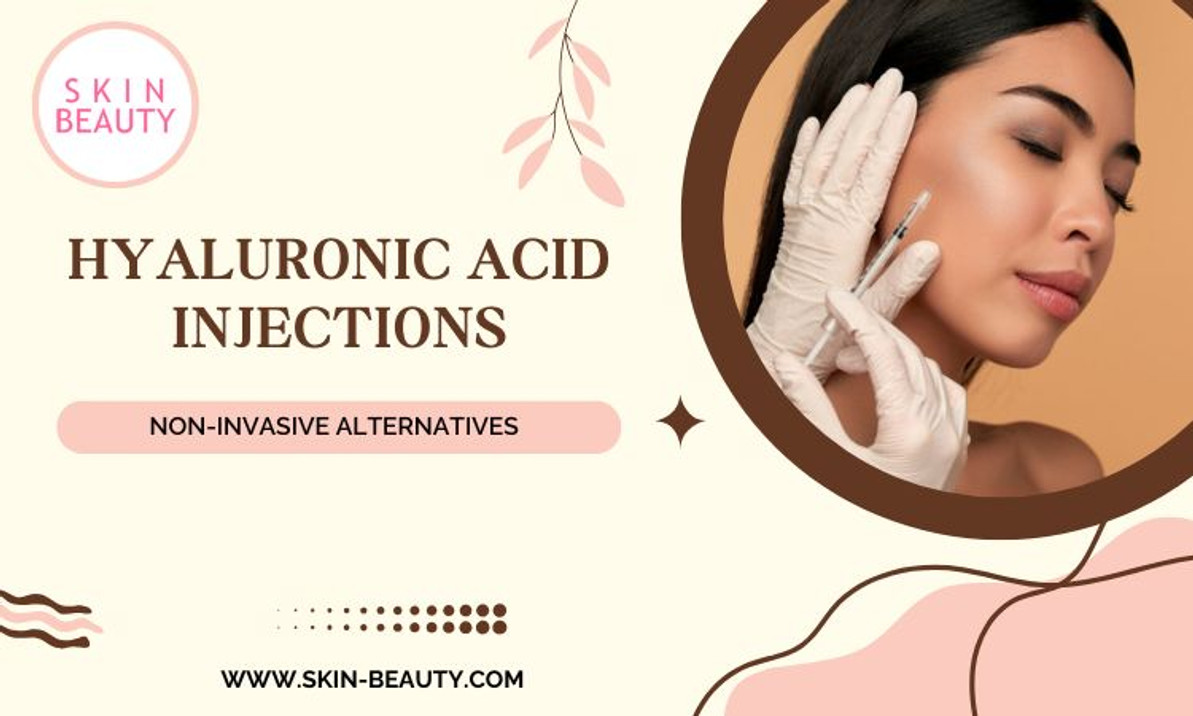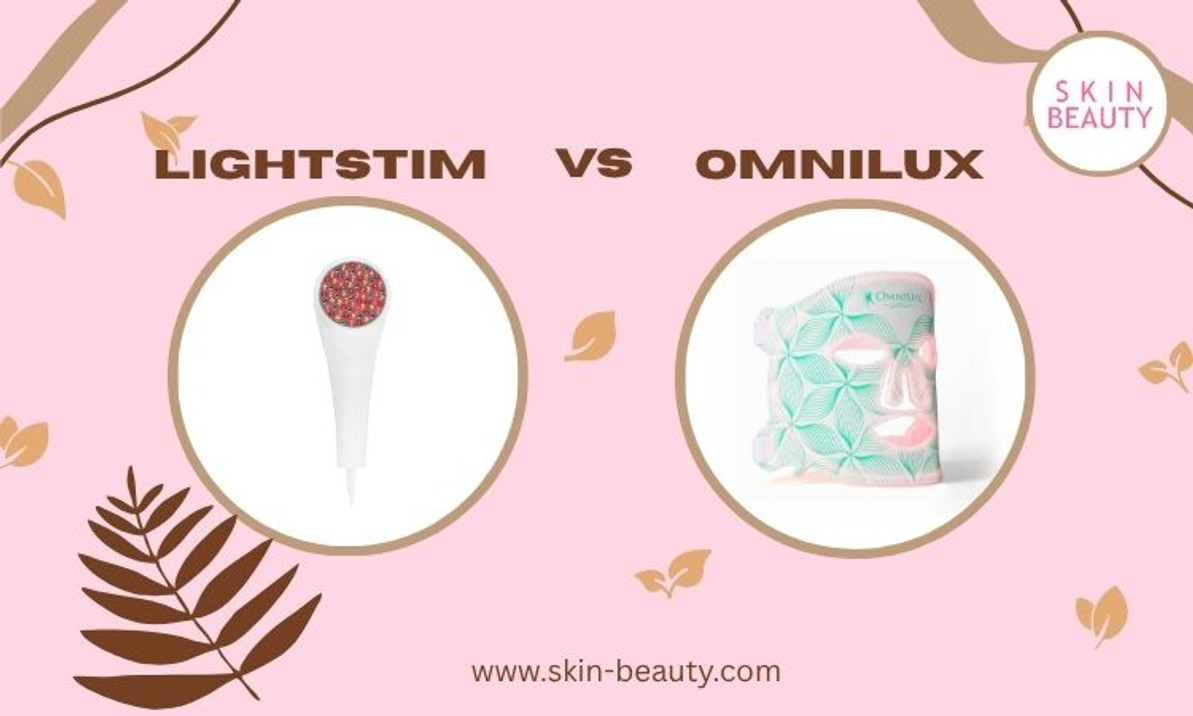Can You Use Hyaluronic Acid with Retinol?
How Can You Use Hyaluronic Acid with Retinol for Radiant Skin in 2023
Imagine unlocking the secret to radiant, youthful skin simply by combining two powerful skincare ingredients. It’s possible! The dynamic duo of hyaluronic acid and retinol has the potential to transform your complexion, providing hydration and reducing the signs of aging. But, can you use hyaluronic acid with retinol? Get ready to explore the remarkable benefits of this power couple and learn how to incorporate them into your skincare routine for amazing results.
In this journey, we will delve into the wonders of hyaluronic acid and retinol, understand their individual benefits, and reveal the ultimate skincare routine that combines them for maximum effect. We will also discuss complementary ingredients, what not to mix with retinol, and expert-recommended products to enhance your skincare regimen. Are you ready to achieve radiant skin? Let’s dive in!
Key Takeaways
- Harness the power of hyaluronic acid and retinol together for smoother, softer, and younger-looking skin.
- Maximize benefits by prepping your skin with cleansing & moisturizing + layering techniques & complementary ingredients.
- Minimize side effects while maximizing results with expert tips such as gradually increasing the concentration of retinol.
The Power Couple: Hyaluronic Acid and Retinol
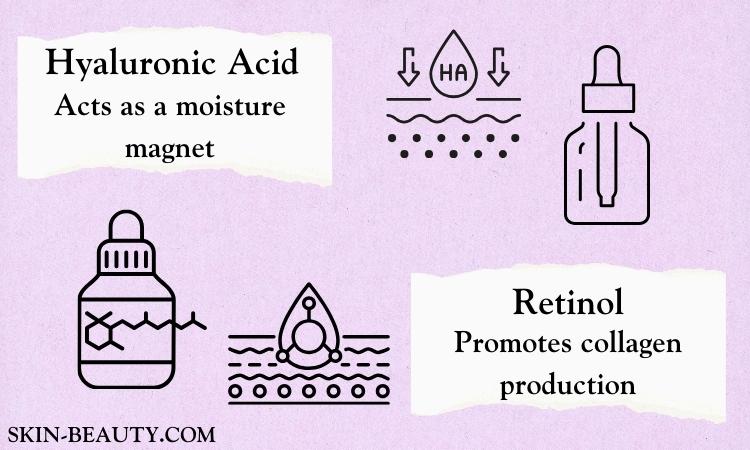
Hyaluronic acid coupled with retinol offers a potent skincare duo that delivers deep hydration and visibly reduces signs of aging, catering even to sensitive skin. They complement each other perfectly, with hyaluronic acid acting like a moisture magnet, drawing water into the skin to hydrate and plump, while retinol boosts collagen production and promotes cell turnover to diminish wrinkles and improve skin texture.
These two potent ingredients can be used together safely, and when combined correctly, they can give you smoother, softer, and younger-looking skin. Hyaluronic acid can be used twice a day for optimal hydration, especially for dry skin, while retinol should be used once a day at night for maximum anti-aging effects.
Ready to harness the full potential of hyaluronic acid and retinol? Get started by getting to know these potent ingredients.
Understanding Hyaluronic Acid
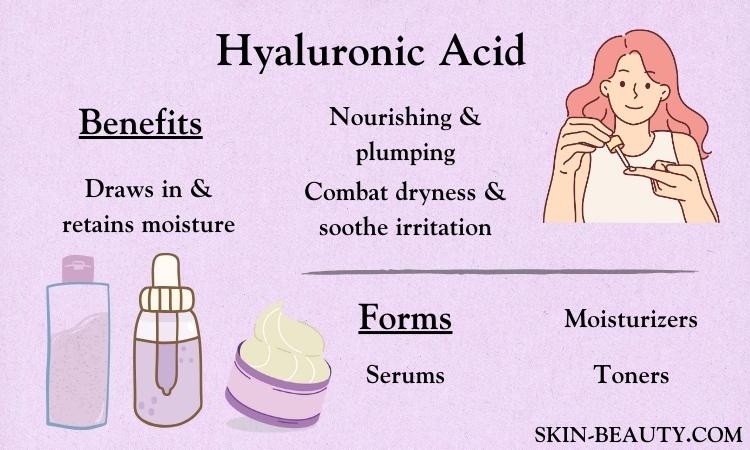
Hyaluronic acid, a natural skincare marvel, boasts an amazing capacity to lock in moisture, imparting a youthful glow to your skin while reducing fine lines and wrinkles. By enhancing your skin’s ability to retain moisture, hyaluronic acid helps by drawing water into the skin like a sponge, providing a nourishing and plumping effect to combat dryness and soothe irritation. Using a hyaluronic acid moisturizer can further enhance these benefits.
You can find hyaluronic acid in a variety of forms, such as hydrating serums, moisturizers, and toners. It also works synergistically with retinol, locking in moisture while retinol boosts collagen production and diminishes wrinkles, providing optimal hydration and anti-aging benefits.
Unveiling the Benefits of Retinol
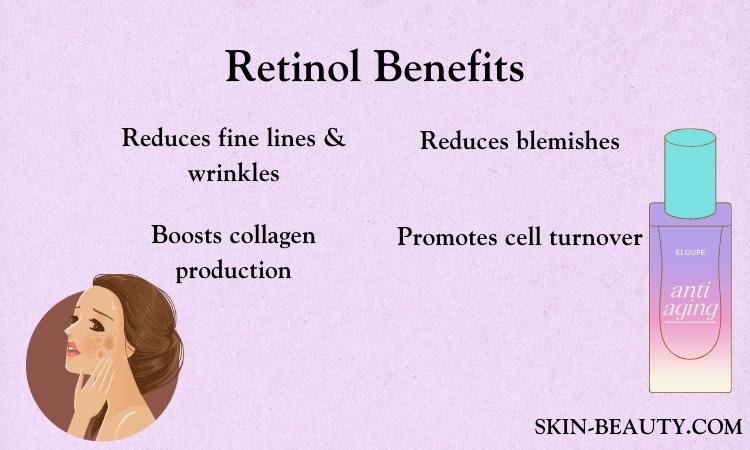
Retinol, a powerful form of vitamin A, is a popular anti-aging ingredient that encourages the skin’s cell renewal cycle, bringing a new layer of skin to the surface quickly. Retinol cream boasts an array of benefits, including significantly reducing the appearance of fine lines and wrinkles and effectively reducing blemishes. Additionally, retinol serum offers similar advantages for those seeking a more lightweight option.
When used in conjunction with hyaluronic acid, retinol can work its magic on skin cells, promoting cell turnover and boosting collagen production to improve skin tone and texture. This potent combination can help you achieve a smoother, brighter complexion with fewer wrinkles.
Combining Hyaluronic Acid and Retinol: The Ultimate Skincare Routine
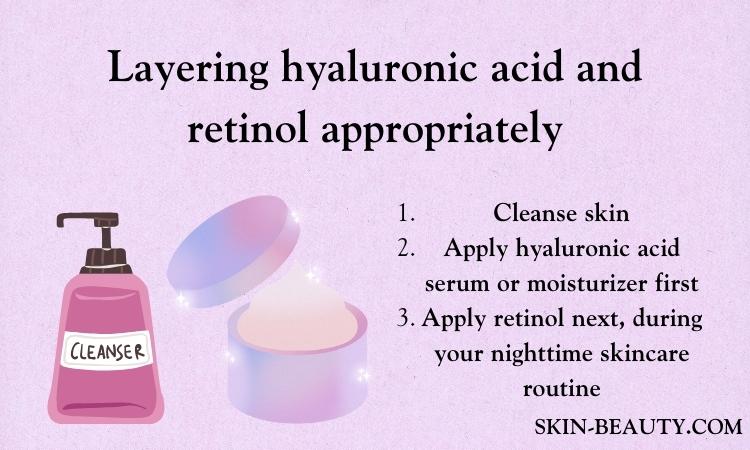
Now that you understand the benefits of hyaluronic acid and retinol, let’s explore the best way to combine them in your skincare routine for maximum results. We will discuss how to properly prepare your skin, layer these powerful ingredients, and determine the best times to use each product.
Prepping Your Skin
Before applying hyaluronic acid and retinol, ensure you cleanse your face with warm water and a gentle cleanser to get rid of dirt, oil, and makeup. Dabbing your skin dry with a clean towel is necessary to maintain its health and safeguard against irritation and blemishes.
Proper skin preparation ensures maximum penetration of hyaluronic acid and retinol, allowing them to work their magic effectively. Applying a moisturizer with hyaluronic acid before a serum with retinol can help optimize the efficacy of the retinol, allowing it to absorb more deeply into the pores for maximum results.
Layering Techniques
After cleansing and drying your face, start by applying a hyaluronic acid product. Here’s how:
- Apply a hyaluronic acid serum or moisturizer to hydrate and soothe the skin, balancing out the future drying effects of retinol.
- Create a physical protective layer on the skin by layering the hyaluronic acid serum or moisturizer.
Once the hyaluronic acid is absorbed, apply the retinol product:
- Gently massage a few drops of the product onto your face and neck.
- Focus on areas showing the most promising signs of rejuvenation.
- Give your skin a few moments to absorb the retinol, ensuring that it penetrates deeply into the pores for maximum results.
Daytime vs. Nighttime Use
While hyaluronic acid is suitable for both morning and evening use to achieve optimal hydration, it’s advisable to use retinol at night, letting it perform its revitalizing action while you rest. During the daytime, it’s important to apply sunscreen with SPF when using retinol, as it can make your skin more sensitive to UV rays.
At night, you can use both hyaluronic acid and retinol for optimal results. This combination will give you the best possible outcome. Start with hyaluronic acid to hydrate the skin, followed by retinol to promote cell turnover and collagen production. This combination can help improve the overall texture and appearance of the skin.
Complementary Ingredients to Enhance Your Skincare Regimen
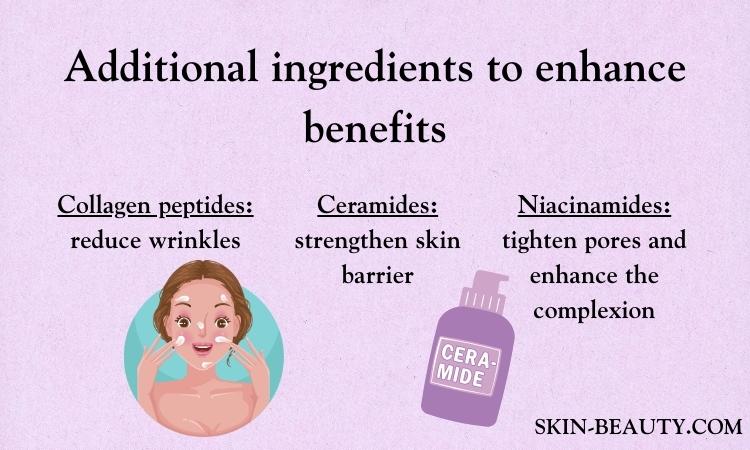
Augment your skincare routine with synergistic ingredients such as ceramides, niacinamide, and collagen peptides to increase hydration and bolster skin health. These ingredients can be added to your hyaluronic acid and retinol routine to maximize their skin-enhancing benefits, providing a comprehensive skincare solution.
For example, some benefits of skincare ingredients include:
- Collagen peptides can help reduce the appearance of wrinkles and firm up sagging skin by boosting collagen production.
- Ceramides help in strengthening the skin’s protective barrier.
- Niacinamide, a form of Vitamin B3, can regulate oil production, tighten pores, and enhance the complexion.
Avoiding Ingredient Conflicts: What Not to Mix with Retinol
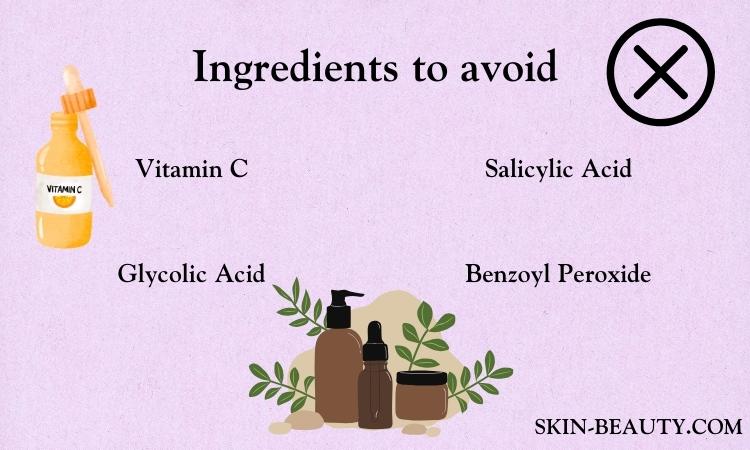
While using retinol, be cautious to not mix it with specific ingredients to avoid skin irritation and diminished potency. Ingredients like vitamin C, exfoliating acids (such as salicylic acid and glycolic acid), and benzoyl peroxide should not be combined with retinol.
Steering clear of ingredient conflicts can promote skin health and boost the performance of your skincare products, fostering a productive synergy between hyaluronic acid and retinol. When in doubt, consult a board-certified dermatologist for personalized advice on combining skincare ingredients safely.
Expert-Recommended Products for Hyaluronic Acid and Retinol
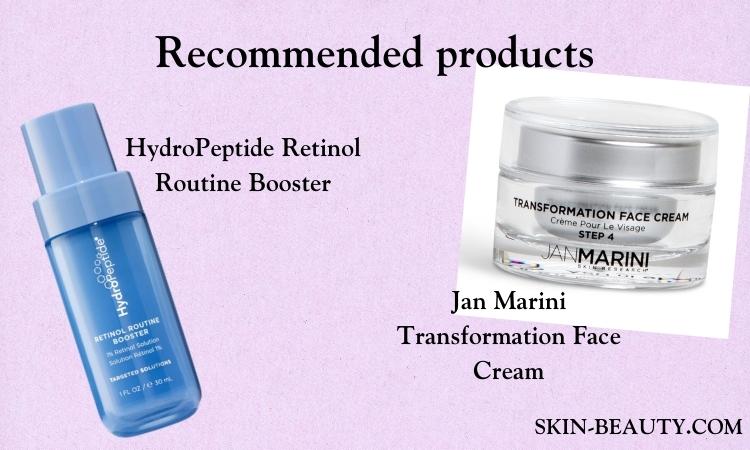
If you’re prepared to commence your journey towards radiant skin, contemplate trying expert-suggested products that fuse hyaluronic acid and retinol, like Neutrogena Hydro Boost Water Gel, HydroPeptide Retinol Routine Booster, and Jan Marini Transformation Face Cream. These products are sure to give you the best results and help you achieve the glowing skin you’ve always wanted.
Tips for Minimizing Side Effects and Maximizing Results
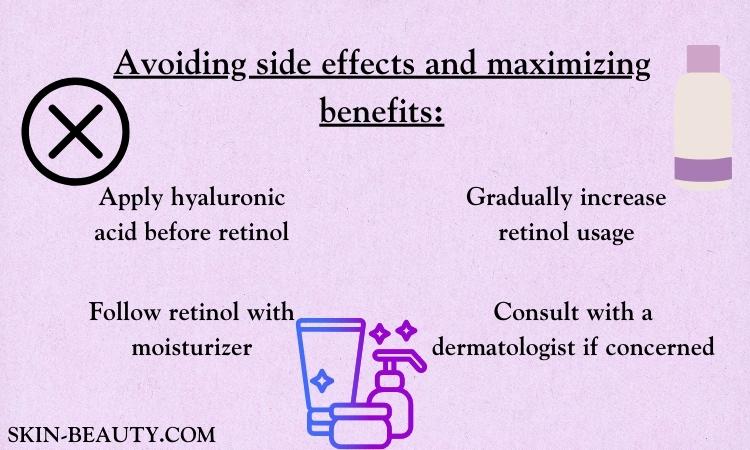
To curb side effects and optimize results while using hyaluronic acid and retinol, heed these useful tips: Initiate by applying a hyaluronic acid serum before retinol to hydrate your skin, and follow up with a moisturizer to maintain nourishment. Gradually increase the concentration of retinol in your skincare routine, and consider using a retinol ester or retinal if the retinol is too strong.
Additionally, here are some tips to keep in mind when incorporating new products into your same skincare routine:
- Perform a patch test before using a new product to observe how your skin reacts and avoid irritation.
- If you’re unsure about how to combine active ingredients, do some research or consult a dermatologist for professional guidance.
- If you have concerns about your skincare routine or specific skin issues, don’t hesitate to consult a dermatologist for personalized advice and recommendations.
Summary
In conclusion, combining hyaluronic acid and retinol in your skincare routine can unlock the secret to radiant, youthful skin. By understanding the individual benefits of these powerful ingredients and learning how to effectively incorporate them into your regimen, you can achieve smoother, softer, and younger-looking skin.
Remember to cleanse and prepare your skin, apply retinol before hyaluronic acid, and incorporate complementary ingredients like ceramides, niacinamide, and collagen peptides for a comprehensive skincare solution. With these tips in mind, you’re well on your way to achieving the glowing skin you’ve always dreamed of.
Frequently Asked Questions
Should I use hyaluronic acid before or after retinol?
For best results, allow your hyaluronic acid serum to dry before applying retinol. If your skin is already accustomed to retinol, it is okay to apply the retinol first then pat on your hyaluronic acid serum.
Can you use hyaluronic acid with retinol?
You can safely use hyaluronic acid and retinol together in your skincare routine to achieve greater results. Hyaluronic acid draws water into the skin and helps counterbalance retinol's drying properties while still allowing it to penetrate the outer layer of the skin. This combination is one of the most popular and beneficial for achieving healthy, glowing skin.
How to use retinol?
Apply retinol in a thin layer to your entire face every other night and gradually increase the frequency, making sure to mix it with your moisturizer. Always use sunscreen the morning after you apply retinol and finish with a non-comedogenic facial moisturizer. Keep in mind that your skin may be sensitive to sunlight while using retinol, so use it as part of your nighttime skincare routine only.
What are some expert-recommended products for Hyaluronic Acid and Retinol?
Try Neutrogena Hydro Boost Water Gel for hyaluronic acid and Doctor D. Schwab Retinol Rejuvenate Night Cream for retinol for expert-recommended results.
What ingredients should not be mixed with retinol?
It's best to avoid combining retinol with vitamin C, exfoliating acids (such as salicylic acid and glycolic acid), and benzoyl peroxide, so you can reap the full benefits of this amazing anti-aging ingredient.
Recent Posts
-
Hyaluronic Acid Injections
Hyaluronic Acid Injections: What to Know & Non-Invasive Alternatives That Actually Work In the p …Jun 17th 2025 -
Kojic Acid Creams
My Kojic Acid Journey: How One Ingredient Transformed My Skin (And the Best Kojic Acid Creams to Try …Jun 11th 2025 -
LightStim vs. Omnilux
LightStim vs. Omnilux: My Real LED Skincare Results & Which One I Recommend LED light therapy&nb …Jun 3rd 2025


